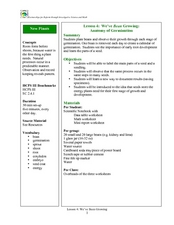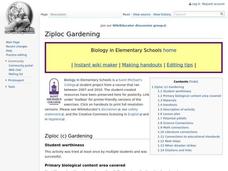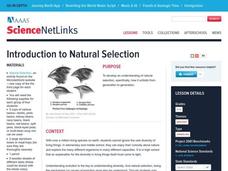Curated OER
Beans, Beaks and Bears
Students explore evolution. After watching a video on evolution, students perform a variety of experiments using beans which illustrate the concept of evolution.
Curated OER
We’ve Bean Growing: Anatomy of Germination
Students identify the main parts of a seed. In this biology lesson, students explain the factors needed for the seed to grow. They record observations everyday and report findings to class.
Curated OER
The Effects of the Calcium Ion on Cooked Dry Beans
High schoolers investigate the effects of calcium ions on the quality characteristics of cooked dry beans. In this calcium ion and dry bean investigation lesson plan, students soak dry beans using 2 different soaking techniques and 2...
Curated OER
Seed Sensations!
First graders examine seeds. In this Science lesson, 1st graders classify and dissect seeds. Students sprout their own seeds in the classroom.
Curated OER
Ziploc Gardening
Students observe beans germinating in a plastic bag. In this bean growing lesson, students predict what their beans will look like. Students draw illustrations to record the changes in their bean plants. Students should also note...
Curated OER
Going Global
Students describe the importance of aquaculture as a source for protein intake by humans globally. They are given a number from 1-3 as they enter the class. All "1's" recieve 10 beans. All "2's" recieve 5 beans. All "3's" recieve 1 bean....
Curated OER
Dried Vs. Soaked Beans
Pupils observe the differences between a dry and soaked bean, and identify the functions and parts of a bean at the beginning of its growth.
Curated OER
Bean There, Done Plant
Students explain that events in nature follow an orderly progression when they plant seeds and observe the development of the seeds. They count seeds and find the likenesses and the differences of many seeds.
Curated OER
Introduction to Natural Selection
Students develop an understanding of natural selection, specifically, how it unfolds from generation to generation. They work in small groups to perform an experiment using beans. They use a worksheet imbedded in this plan to guide their...
Curated OER
Calculating the Average Mass of the Newly Discovered Element: Bean
Learners determine the average mass of a new element using masses from three isotopes. In this chemistry lesson, students explain what an isotope is. They discuss their importance and uses.
Curated OER
Coal Supply and Demand
A hands-on simulation perfect for an economics instructional activity, young learners investigate the availability of different sources of natural energy (coal, natural gas, oil, solar, and nuclear) and how this availability affects...
Grand Erie District School Board
Model Cell Project
If you're finishing up a unit on cells, here's a great project to get kids collaborating and recalling what they've learned in a fun and tangible way. Small groups create plant or animal cells out of materials they have at home. They use...
Curated OER
Exploring Scale And Ratio
Learners measure the actual size and distance of the solar system using scale and ratio. They watch and discuss a video, create a distance-scale solar system model, and compare the scale sizes of planets to their actual sizes.
Laboratory for Atmospheric and Space Physics
A Classroom Solar System
Create a scaled model of our solar system in your classroom! Scholars work collaboratively to build paper mache planets and hang them in their proper position to showcase each planet's location in the solar system.
Curated OER
Anatomy- Excretory System
Fourth graders explore, analyze and identify the structures and order the process of the excretory system through a model or a diagram. They assess the names and locations of the organs involved in the excretory process, as well as...
Curated OER
Fun Activities Using Seeds
Students analyze the size, shape, and form of several different seeds. In this all about seeds lesson plan, students complete four activities involving characteristics of seeds. Students observe the seeds, record information about the...
Curated OER
It May Be Yucky, But Someone Has To Teach It. . .
Fourth graders study the names and parts of the excretory system in this hands-on activity. They use common items to make a model of the system.
Curated OER
How Does a Green Plant Grow?
Students of all ages can explore the question "how do seeds grow?", design an experiment to answer the question, predict the outcome of the experiment then conduct the experiment.
Curated OER
Calories and Nutrition
In this calories activity, students use a chart comparing the calories found in different food items to complete 3 short answer questions.
Curated OER
Net Results
Students investigate through role play how decisions by watermen, recreational fisherpeople, and lawmakers influence and are influenced by economics and the abundance or scarcity of fish and shellfish stocks. They consider social,...
Curated OER
Cells All Around
Students measure the size of an epithelial cell and to estimate the number of epithelial cells in a given area of the body. After watching a video on cells, student groups perform an experiment using a microscope to view some of their...
Curated OER
Cell Parts
In this biology worksheet, learners read about the parts of both plant and animal cells and examine cell diagrams. They read about the function of cell parts before answering 11 online fill in the blank questions.
Curated OER
Animal Adaptations
Fifth graders discover the adaptation of species through analyzing pictures. In this scientific discovery lesson, 5th graders discuss the concept of adaptation in order for survival. Students view many images of extinct...
Curated OER
Birth of a Plant From a Seed
Students sow seeds of learning. In this biology lesson plan, students label parts of a dicotyledon seed by function as well as by proper names.























